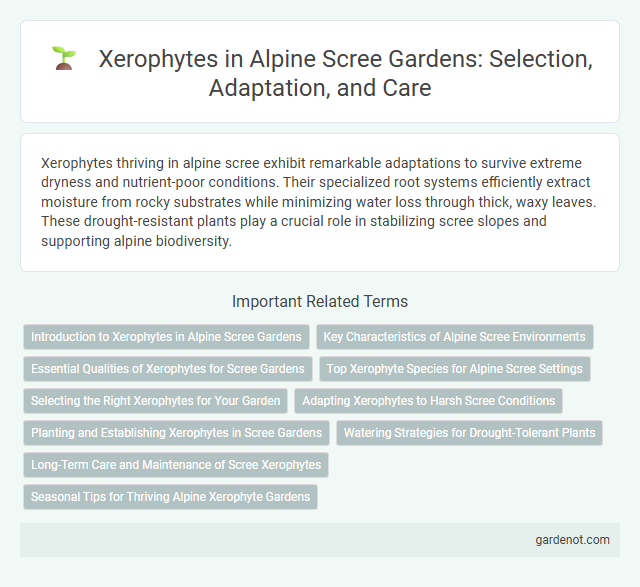Xerophytes thriving in alpine scree exhibit remarkable adaptations to survive extreme dryness and nutrient-poor conditions. Their specialized root systems efficiently extract moisture from rocky substrates while minimizing water loss through thick, waxy leaves. These drought-resistant plants play a crucial role in stabilizing scree slopes and supporting alpine biodiversity.
Introduction to Xerophytes in Alpine Scree Gardens
Xerophytes in alpine scree gardens exhibit remarkable adaptations to survive extreme drought and poor soil conditions typical of high-altitude scree slopes. These plants possess specialized features such as thick cuticles, reduced leaf surfaces, and deep root systems to efficiently conserve water and anchor in unstable, rocky substrates. Their presence enhances biodiversity and stabilizes fragile scree ecosystems while providing unique ecological niches in harsh alpine environments.
Key Characteristics of Alpine Scree Environments
Alpine scree environments are characterized by loose, rocky debris and intense solar radiation, creating extreme moisture scarcity that xerophytes have adapted to survive. These plants exhibit specialized features such as deep root systems for water extraction, thick cuticles to minimize transpiration, and small, often needle-like leaves to reduce surface area. Their ability to thrive in nutrient-poor, well-drained substrates highlights xerophytes' key adaptive strategies in alpine scree habitats.
Essential Qualities of Xerophytes for Scree Gardens
Xerophytes thrive in alpine scree by exhibiting essential qualities such as deep root systems that maximize water absorption and thick, waxy leaves that reduce moisture loss. Their ability to survive in nutrient-poor, well-drained rocky soils with extreme temperature fluctuations is crucial for scree garden sustainability. Adaptations like succulence and drought-resistant metabolism enable xerophytes to maintain hydration and photosynthesis under harsh, arid conditions.
Top Xerophyte Species for Alpine Scree Settings
Top xerophyte species thriving in alpine scree settings include Saxifraga longifolia, known for its deep root systems and drought resistance, and Silene acaulis, which forms cushion-like mats that reduce water loss and protect against harsh winds. Sedum species, particularly Sedum alpestre, exhibit succulent leaves that store moisture, making them well-adapted to nutrient-poor, rocky substrates. These plants exhibit specialized adaptations such as xeromorphic leaves and efficient water storage, enabling survival in the extreme conditions of alpine scree environments.
Selecting the Right Xerophytes for Your Garden
Choosing the right xerophytes for your Alpine scree garden involves selecting drought-tolerant species such as Sedum, Sempervivum, and Delosperma, which thrive in well-drained, rocky soils. These xerophytes exhibit adaptations like succulent leaves and deep root systems, ensuring survival in harsh, arid conditions typical of scree slopes. Proper selection enhances landscape resilience and promotes water-efficient gardening in alpine environments.
Adapting Xerophytes to Harsh Scree Conditions
Xerophytes exhibit remarkable adaptations to thrive in harsh alpine scree environments, characterized by dry, rocky, and nutrient-poor substrates. Their succulent leaves and deep root systems enhance water retention and absorption amid sporadic moisture availability. Specialized physiological mechanisms such as CAM photosynthesis minimize water loss, ensuring survival under extreme temperature fluctuations and intense solar radiation.
Planting and Establishing Xerophytes in Scree Gardens
Xerophytes thrive in alpine scree gardens due to their drought-resistant adaptations and ability to endure poor, rocky soils with excellent drainage. Planting xerophytes requires selecting species such as Sedum, Sempervivum, and Saxifraga that establish well in scree environments by developing deep roots and minimal water requirements. Ensuring proper soil composition with coarse grit and maintaining full sun exposure promotes successful establishment and longevity of xerophytic plants in scree gardens.
Watering Strategies for Drought-Tolerant Plants
Xerophytes in alpine scree environments employ specialized watering strategies such as deep root systems and water-storing tissues to survive prolonged droughts. These drought-tolerant plants minimize transpiration through reduced leaf surface area and protective waxy coatings. Efficient water use and storage enable xerophytes to thrive in nutrient-poor, rapidly draining scree substrates.
Long-Term Care and Maintenance of Scree Xerophytes
Long-term care and maintenance of alpine scree xerophytes involve minimal watering to mimic their natural arid environment, ensuring well-drained soil to prevent root rot. Regular monitoring for pests and diseases supports their resilience in harsh alpine conditions, while pruning dead or damaged foliage encourages healthy growth. Seasonal mulching with coarse gravel helps stabilize soil temperature and moisture, promoting sustained plant vitality in scree habitats.
Seasonal Tips for Thriving Alpine Xerophyte Gardens
Alpine xerophyte gardens thrive by mimicking natural seasonal conditions, ensuring well-drained, gritty soil to prevent root rot during wetter months. Implementing a strict watering schedule that reduces moisture in winter and increases slight hydration in early spring supports plant dormancy and growth cycles. Mulching with gravel or small stones helps maintain temperature stability and discourages moisture retention, essential for xerophytes in alpine scree environments.
Xerophyte Infographic

 gardenot.com
gardenot.com